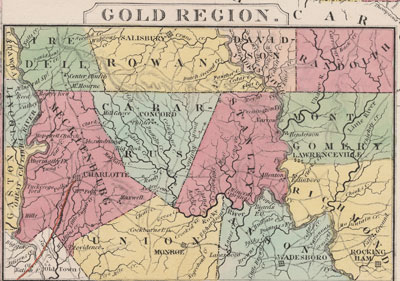With the battle over the state budget now behind them, legislators in Raleigh moved on to pondering other weighty matters-like selecting the official state sport and state mineral. In a nod to Junior Johnson, Richard Petty and the Charlotte Motor Speedway (pictured in the postcard above), lawmakers voted to make stock car racing the state sport. Apparently some fans of another sport, the one that claims the attention of many from November to early April, raised some objections. But, alas, they gave up their cause when it was noted that basketball’s birth occurred in western Massachusetts.
Proponents of gold (and who isn’t?) weren’t so eloquent in their argument for making the precious metal the state’s official mineral. But, perhaps, few need convincing that gold holds a special place in Tar Heel history. Conrad Reed’s discovery of gold on his family’s Cabarrus County farm in 1799 set in motion the nation’s first gold rush. Other discoveries followed nearby (the inset below, from an 1850s map of the state, shows the “gold region”) . During the peak years of gold production in North Carolina, between the late 1820s and 1830s, the state’s mining industry employed over 30,000 people and ranked second only agriculture in its importance to the economy.
We’re thinking these two pieces of legislation are veto-proof. Do you think otherwise?



